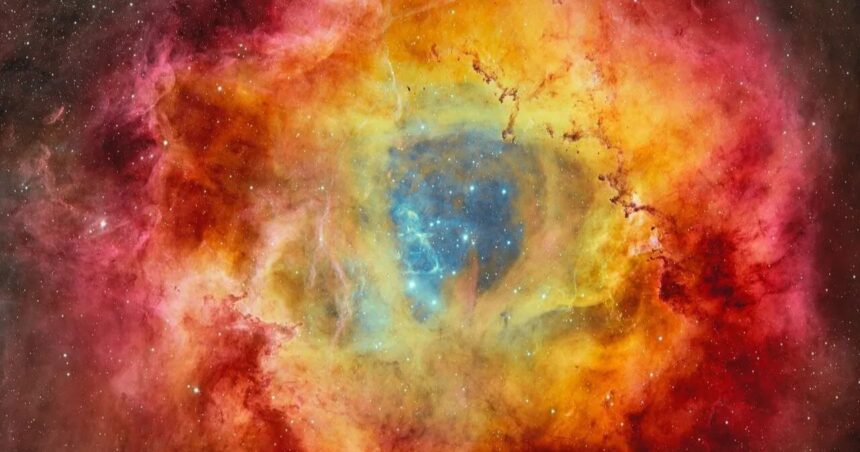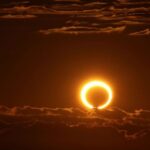Astronomers captured a breathtaking image of the Rosette Nebula. This stunning nebula, located about 5,000 light-years away, is a true marvel of the cosmos. The Rosette Nebula is a massive cloud of gas and dust, shaped like a beautiful rose. It is found in the constellation Monoceros, also known as the Unicorn.
The Rosette Nebula is a star-forming region. At its heart lies a cluster of young, hot stars known as NGC 2244. These stars are very bright and emit a lot of ultraviolet radiation. This radiation energizes the surrounding gas, causing it to glow in vibrant colors. The nebula’s red, gold, and pink hues are a result of this process.
The image of the Rosette Nebula was taken by the Dark Energy Camera (DECam) mounted on the Víctor M. Blanco 4-meter Telescope in Chile. This camera has a resolution of 500 megapixels, allowing it to capture the nebula in incredible detail. The DECam is part of the Cerro Tololo Inter-American Observatory, which is operated by the National Optical-Infrared Astronomy Research Laboratory (NOIRLab).
The Rosette Nebula is an emission nebula. This means that it emits light at specific wavelengths due to the ionization of its gases. The red color in the nebula comes from hydrogen gas, which is the most abundant element in the universe. The golden yellow color is due to ionized oxygen, while the pink color is from ionized silicon.
The Rosette Nebula is not just a pretty sight. It is also a region of intense star formation. The young stars in the NGC 2244 cluster are only a few million years old. They have not yet reached the end of their life cycle. These stars are very massive and will eventually explode as supernovae. This will create even more complex structures within the nebula.
The central cavity of the Rosette Nebula is a result of the powerful winds and radiation from the young stars. These forces have cleared out the gas and dust in the center, creating a hollow region. The edges of the nebula are dense with gas and dust, forming intricate patterns and shapes. Some of these structures are known as “elephant trunks” because of their long, narrow appearance.
Astrophotographers often aim for the Rosette Nebula. Its bright colors and unique shape make it a favorite among stargazers. The nebula is best viewed during the winter months in the northern hemisphere. It is located near the constellation Orion, which is one of the most recognizable constellations in the sky.
The Rosette Nebula is also a subject of scientific study. Astronomers are interested in understanding the processes that lead to star formation. By studying the Rosette Nebula, they can learn more about how stars and planetary systems form. This knowledge can help us understand the origins of our own solar system.
The Rosette Nebula is a reminder of the beauty and complexity of the universe. It shows us that even in the vastness of space, there are regions of incredible beauty and activity. The nebula’s vibrant colors and intricate structures are a testament to the dynamic nature of the cosmos.
Editor’s Recommendations
- Once-in-a-Lifetime Event: Corona Borealis Constellation Shine Brighter as Nova Explosion
- Hubble’s Shocking Discovery, Supermassive Black Hole Jets Trigger Explosive Novas
- Annular Solar Eclipse on Oct. 2, Witness the Sky’s Fiery Ring at Breakneck Speed
- Once-in-a-Lifetime Event: Corona Borealis Constellation Shine Brighter as Nova Explosion




